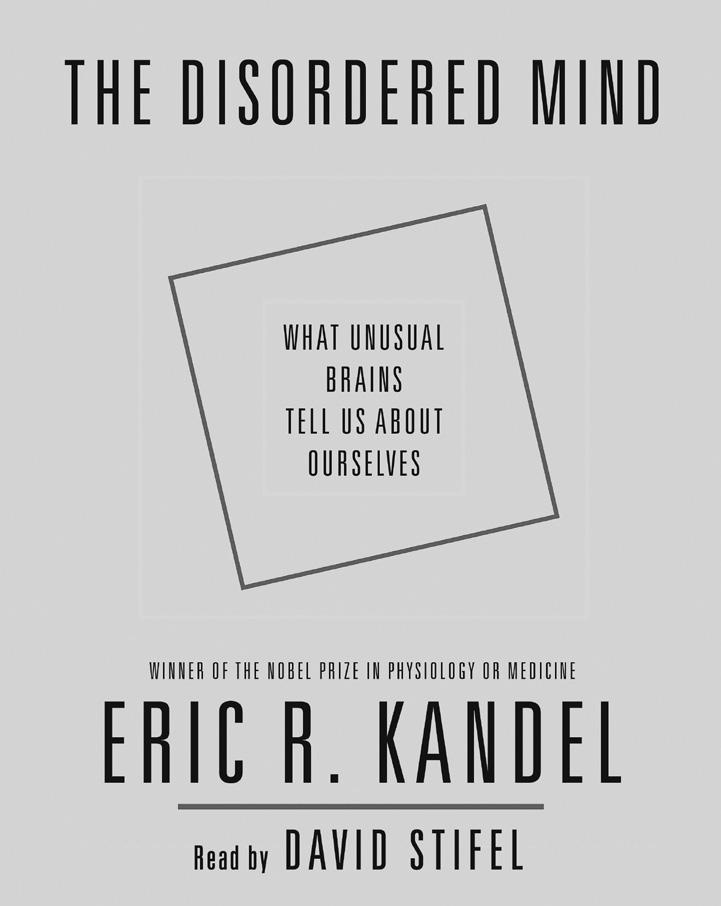
4 minute read
A Review of Eric Kandel’s The Disordered Mind: What Unusual Brains Tell Us About Ourselves
by Pro Tem
Anna Noumtinis
Bilingual Journalist
Advertisement
Eric Kandel, the psychologist who won a Nobel Prize in Physiology or Medicine for his work on learning and memory, is also the author of The Disordered Mind: What Unusual Brains Tell Us About Ourselves. Within its 255 pages are 12 chapters, each of which focuses on a specific brain disorder. The book follows a structure similar to a textbook, with in-depth discussions of psychological disorders and the brain areas affected by said disorders, accompanied by relevant research. The atypical behaviours exhibited by patients with a given psychological disorder are examined, and further contrasted with the behaviours of those without the aforementioned disorder. Through these analyses, Kandel uses these disorders to highlight the different brain structures at play when various human behaviours are presented. He makes reference to case studies, experiments, and other types of research conducted that have mapped these disordered or damaged brain areas, which were used to de- termine the parts of the brain used for each specific behaviour. The text also touches on treatment options developed for these disorders, which use intact areas or behaviour strategies to compensate for the damaged ones. Kandel summarises the studies and research in an easily digestible manner, making it simple to comprehend the main results and purpose of his studies.
Each chapter is unique, in that it describes living with the highlighted disorder; some chapters contain biographies and quotes from interviews of individuals living with the disorder, while others contain mere vignettes. The biographies and personal anecdotes are touching, and give hope to the reader, that life with a psychological disorder can still be fulfilling, triumphant, and happy. The explanations of just what occurs in the minds of patients with these disorders helps to clear many stereotypes and misconceptions. Helpful diagrams of the brain and examples of famous individuals with brain disorders can be found among other images.
This book has furthered my understanding of of the experiences of those with psychological disorders, and where science and society need to be applied, in order to improve life for these individuals. It is people like Kandel who bridge the gap between scientific concepts and real-world applications; it is difficult to work at making daily living increasingly stable, and less debilitating, when you don’t fully understand what these individuals are going through. I really love that Kandel gives credit where due, showing readers through research and science that everything we know about the inner workings of the human brain are due to those who suffer from brain disorders or damage. At the end of each chapter, he talks brifly about the direction of future research, therapies, and science, as well as what needs to be done to further advance treatments.
If you are studying psychology, especially neuropsychology, I highly recommend this book to boost your knowledge of psychological disorders, or explore the world of psychological disorder research.
As you can tell, this book is definitely science-heavy, with a lot of terminology about the brain, and references to concepts and constructs of the brain’s biology. This means that having a background in neu- une industrie cinématographique qui les considère comme plus que de simples stéréotypes. Le dernier prix que le film a reçu a été décerné à Jamie Lee Curtis, qui jouait Deirdre. Elle a remporté l’Oscar de la meilleure actrice dans un rôle secondaire, face à sa partenaire, Stephanie Hsu, qui jouait Joy. Dans l’ensemble, Everything Everywhere All At Once mérite toute la reconnaissance qu’il peut recevoir. Je vous recommande vivement de le regarder si vous ne l’avez pas encore fait. ropsychology, psychology or biology will likely make it easier to understand. However, there are so many online resources available that even if the sciences are not your forte, you could do some preliminary research about the topics, terms and concepts that are unfamiliar to you. Although I am reading this book for my case studies in a psychology course, as a part of the Cognitive Neuropsychology stream, I wanted to bring it to the attention of the rest of the Glendon community. This book is extremely well-written, and I was impressed by how easy it was to read and understand the content!





